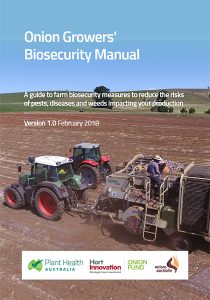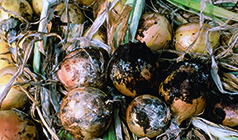Read the latest information on
Foot-and-mouth disease
 For the first time, onion growers across Australia have a manual dedicated to their biosecurity needs.
For the first time, onion growers across Australia have a manual dedicated to their biosecurity needs.
Stuart Kearns, Manager for Farm Biosecurity at Plant Health Australia, said that the new manual will help onion growers secure their future by making better biosecurity decisions.
“The Onion Growers’ Biosecurity Manual has been developed around the six Farm Biosecurity essentials that have been tailored to address situations that onion growers can relate to,” Mr Kearns said.
“A biosecurity checklist, customised for onion growers, has been included in the manual.”
Three levels of biosecurity practice are described: baseline, industry standard and above industry standard. In some cases, there are legal requirements which must be met before best practice management in considered.
Mr Kearns said that on farm biosecurity is about the ways we manage pest and disease risks across the farm.
“There is no single way to manage pest and disease risks on farm,” he said.
“There are many varied approaches being undertaken to suit the different farming systems, circumstances and risk profiles of farm businesses.”
Two case studies in the manual highlight how different on-farm biosecurity measures were used to eradicate or control the spread of onion diseases.

Onion plants with symptoms of the onion smut disease in the field. Howard F. Schwartz, Colorado State University, Bugwood.org
Biosecurity measures were invaluable in the eradication of the damaging fungal disease called onion smut which first struck onion growers in South Australia in 1979, sparking an eradication effort that lasted almost four decades.
Australia is once again free from this disease, but ongoing surveillance is required to provide evidence that our produce is onion smut free.
The eradication program has been long and involved. The affected crops were destroyed, infected paddocks disinfected, equipment cleaned, and strict on-farm biosecurity measures were implemented. Then there was a long wait.
Fifteen years of quarantine was required to make sure that no spores remained in the soil, so no onions or other Allium crops could be grown for that period.
The disease was last detected in 2002, and quarantine restrictions ended in October 2017. The eradication program relied on consistent use of on-farm biosecurity practices to prevent onion smut spreading further.
It could happen again. Onion smut is spread in contaminated soil: in this case shared harvest bins were linked to spread of the disease between growers and packing sheds.

White fluffy bulbs are a key sign of white rot. Onions Australia Poster
The story of white rot is quite different. It was an exotic pest to Australia but was somehow introduced in the 1960s. The disease went unreported and, with few growers managing biosecurity risks on farm, it spread quickly.
The disease had a devastating impact on onion growers. It’s estimated that in the late 1940s, 60,000 tonnes of onions were produced in western Victoria around Colac and Port Fairy. Once white rot became established, soils in the region became so heavily infested that production of onions fell to less than 5,000 tonnes.
Onion growers still have to contend with white rot today. It has spread to all onion growing states except Western Australia, and strict movement controls are in place to maintain area freedom. On-farm biosecurity measures will slow its spread into new areas.
Hard copies of the manual have been printed and will be distributed to growers by Onions Australia.
Electronic copies are available from the new Onions section of the Farm Biosecurity site. The onion toolkit in the Farm Biosecurity profiler includes the manual, a biosecurity checklist, a pest surveillance record sheet, visitor register and a template for a biosecurity sign.